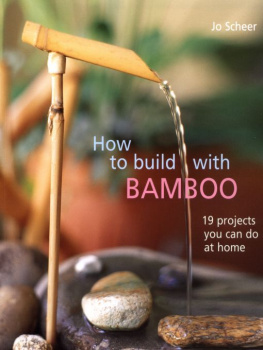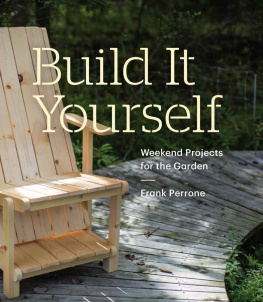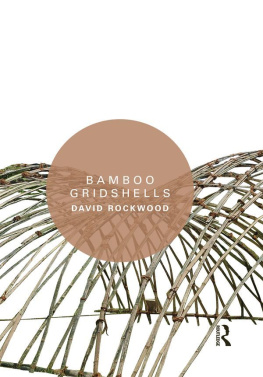Table of Contents
19 projects you can do at home
Jo Scheer
Illustrations by Andrew Schaper
Photographs by Richard G. B. Hanson II, Jo Scheer and Paul Avis
ACKNOWLEDGEMENTS
I would like to thank the staff of the Tropical Agriculture Research Station in Mayaguez, Puerto Rico, for their professional assistance in procuring and identifying the bamboo at the station. The huge selection and variety of bamboo available to me greatly extended my creative horizons and enhanced my personal bamboo appreciation and experience.
First Edition
08 07 06 05 04 5 4 3 2 1
Illustrations 2004 Andrew Schaper
Photographs 2004 Richard G. B. Hanson II,
Jo Scheer and Paul Avis
All rights reserved. No part of this book may be reproduced by any means whatsoever without written permission from the publisher, except brief portions quoted for purpose of review.
Every effort has been made to ensure all the information in this book is accurate; however, due to differing conditions, tools, and individual skills, the publisher cannot be responsible for the outcome of your project.
The publisher and author encourage you to take all safety precautions that would be usual when working with shop tools and materials. They bear no responsibility for any injuries, losses, and other damages that may result from the use of the information in this book.
Published by
Gibbs Smith, Publisher
P.O. Box 667
Layton, Utah 84041
Orders: 1.800.748.5439
www.gibbs-smith.com
Designed by Kurt Wahlner
Produced by Steven Rachwal Design
Printed and bound in Hong Kong
Library of Congress Control Number: 2004108297
ISBN 1-58685-220-5
Dedicated to Laura, Sam, & Sophie, who have tolerated
my bamboo predilection.
INTRODUCTION
Bamboo grows on you. It will grab your consciousness and there will be no turning back. Once awareness has been ignited, bamboo will become part of your life. For those lucky enough to have bamboo a part of their natural world, it is a no-brainer. Bamboo will serve them in many waysin play, in work and in life.
Bamboo is user-friendly, low-tech and easy to work with. Artisans and rural folk in the East have known this for millennia. My experience with bamboo spans twenty years, and bamboo projects have brought me immense satisfaction. With basic tools, a natural material and a synergy of hand and mind, all things are possible-some of which are detailed in the pages that follow. Hopefully, this will be only the beginning, with the techniques and ideas serving as platforms for yet more.
Bamboo, as a raw material or as a prop for life, fits into a much broader philosophy. The incorporation of bamboo into your life fits a lifestyle that reflects an awareness of the natural world, our place within it and a consequent behavior that exemplifies the relationship. We become aware of the necessity to live within the natural constraints of natureto live in harmony, to live sustainably, and to be reverent.
In the East, bamboo has been revered for centuries for its beauty, utility, resilience and simplicity. Bamboo is all these things, and more. It is a gift to man. Work with it for fun, make something that gives pleasure and you will realize the gift. Its employment for the most pedestrian of uses elevates the use to something more. A fence? Commonplace. A bamboo fence? Art. Utility, though an apt application of bamboo, is not the real achievement. It is how the bamboo does its job. Bamboo makes the ordinary extraordinary. A bamboo anything is special. Perhaps we recognize the personal human input, to fashion this thing from the raw material. We see how the bamboo yielded to this design, and we see how it is so appropriate and efficient.
GETTING STARTED
Bamboo can be worked into anything-from towering tree houses to toothpicks. It is not much fun to make toothpicks, and a tree house, though a very worthy endeavor, is a large project. Fortunately, most projects with bamboo are of a scale that they can be completed in one day or less. Inspiration can come at any time, although collecting tools and materials may require a more extended time period. Once set up, however, a project can be worked through the day and finished in time for reflection of the day well spent.
First, you will need bamboo. There are a number of retail outlets around the country that are more than willing to sell you bamboo of all shapes and sizes. A quick and easy resource is the American Bamboo Society Web page, www.abs.org. They have a list of retailers, growers and importers, as well as a slew of information. The bimonthly magazine lists the membership every year, and you can find members that live in your vicinity. Communication with these often knowledgeable people may elicit a source for your bamboo project. They often know of local bamboo stands or know of someone else that does. Another source is nurseries or even botanical gardens. And, upon acquiring permission to cull some bamboo, the actual harvesting must be done in a clean and efficient manner. The bamboo will benefit from removal of dead bamboo culms, which are often the best, as they are cured and have low moisture content. The stand must be left neat and tidy, or you may not have permission to return. The American Bamboo Society is another place to find bamboo aficionados.
Secondly, you will need tools. If you already have a history of woodworking, you will have acquired an inventory of tools easily adaptable to working with bamboo. Some additional tools may be needed and are best to have before you start.
TOOLS
For smooth, fast, precise and loud bamboo shaping, you cant beat a good power tool. The alternative is muscle power, which has its place and is definitely quieter. Hand tools will be best for quick and specific shaping.
Belt Sander: I like the belt sander. It smoothes rough edges quickly. It can be used to fine tune an angle cut or make an otherwise difficult shape. I use cylindrical belt sanders to smooth out holes or adjust them to the eccentricity of a particular piece of bamboo to be inserted.
Brass or Galvanized Wire, 18 to 20 gauge: To prevent splits from continuing through a node, I wrap wire around the culm in two to three loops. Depending on the piece and the use, I use either brass or galvanized wire, 18 to 20 gauge.
Cordless Drill: The cordless drill, with a full complement of hole saw sizes, is something I use often.
Power Compound Mitre Saw: I am enamored with the power compound mitre saw and its 80-tooth, 12 blade that easily cuts through bamboo. I like the precise angles possible and the tight fits that can be achieved. With mitred bamboo, an otherwise difficult joint can be done with ease.

















